Lecture 5: Organizing the start-up
1/28
There's no tags or description
Looks like no tags are added yet.
Name | Mastery | Learn | Test | Matching | Spaced |
|---|
No study sessions yet.
29 Terms
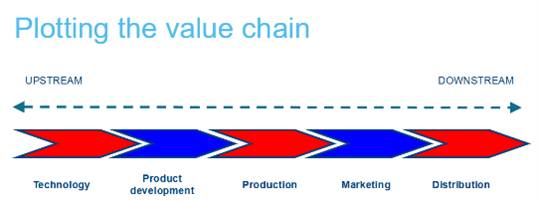
What is the definition of a value chain?
The value chain provides a snapshot of the industry structure and identifies key players a business needs to work with to deliver a product or service to the end customer.
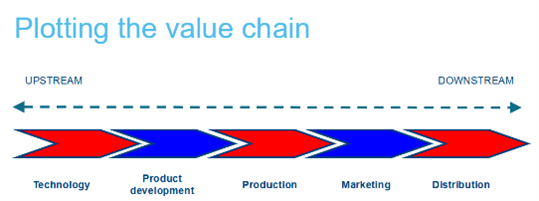
Why is value chain analysis important for start-ups?
It helps start-ups map out their industry structure, identify activities, evaluate competitive position, and highlight opportunities and challenges.
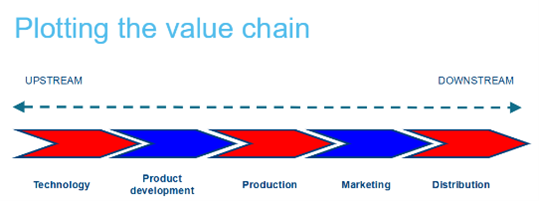
What are upstream and downstream activities in the value chain?
Upstream activities involve technology and product development; downstream activities involve marketing and distribution.

How does the value chain impact the business model?
The analysis helps anticipate how the start-up’s position in the value chain will shape its business model, including revenue streams, partnerships, and risks.
This is particularly important for start-ups, as their limited resources mean they must carefully prioritize which parts of the value chain to focus on and where to collaborate.
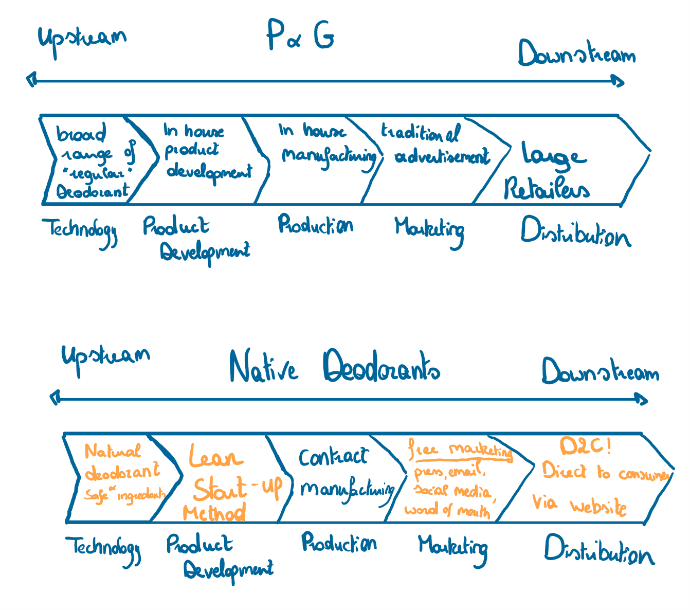
How did Native Deodorants disrupt the value chain of traditional players like P&G?
By using an active feedback loop through the lean start-up method and a direct-to-consumer model.
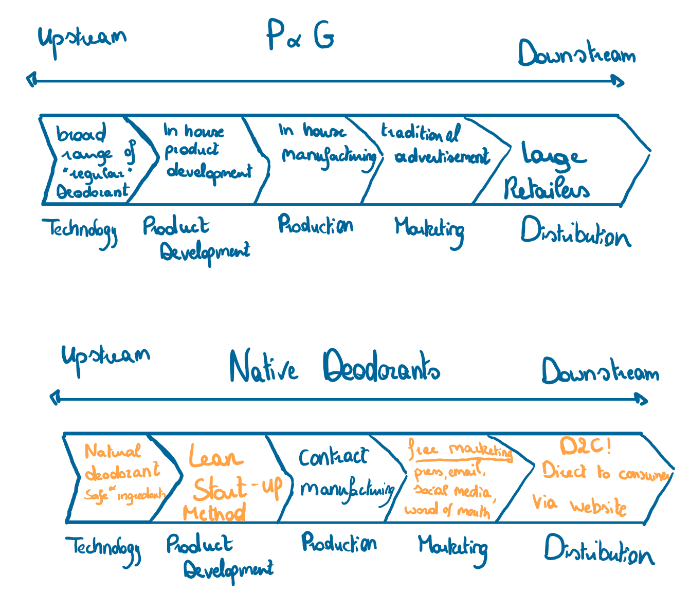
What is an active feedback loop in the context of Native Deodorants?
A method for quickly testing and iterating products based on direct customer feedback.
This approach allowed rapid product iteration and ensured product-market fit early on, allowing Native to adapt to changing customer preferences faster than P&G.

What is the product development of traditional players like (P&G)
Follow long, rigid product development cycles with heavy investment in R&D to perfect products before launch.
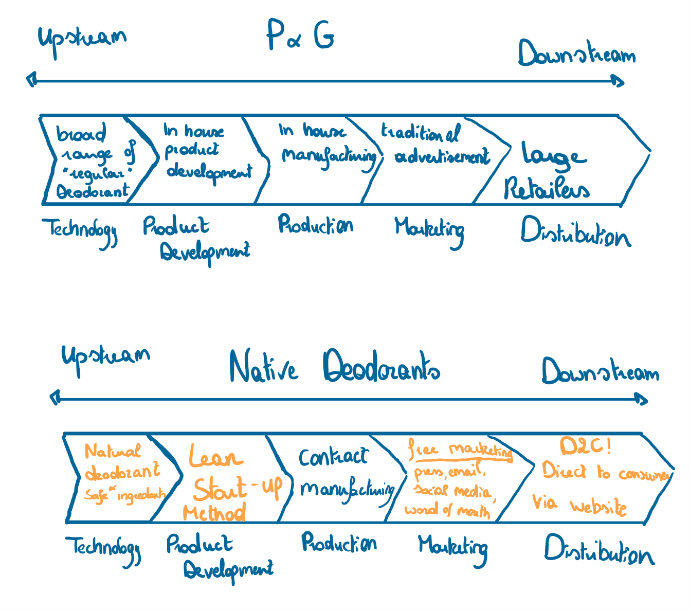
Explain the direct-to-consumer (D2C) model used by Native Deodorants.
A sales model where products are sold directly to consumers, eliminating intermediaries and providing a personalized customer experience.
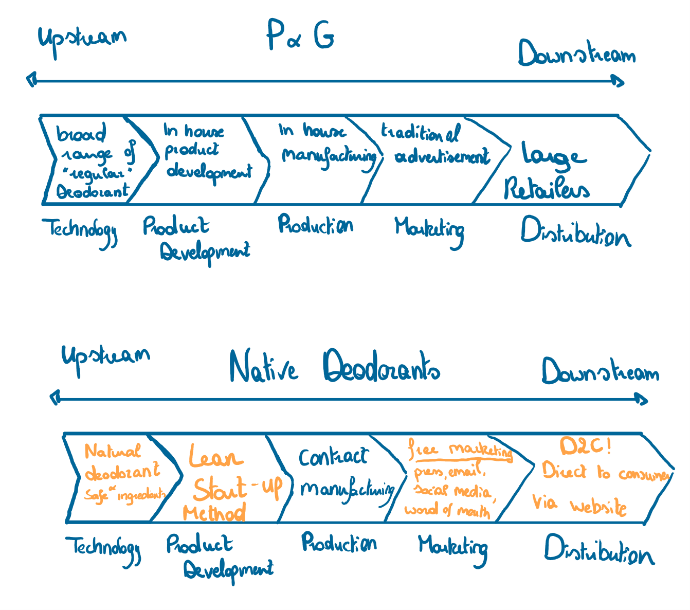
Explain the distribution for traditional players like P&G
Depends on extensive wholesale and retail networks, adding layers of intermediaries between the company and end customers.
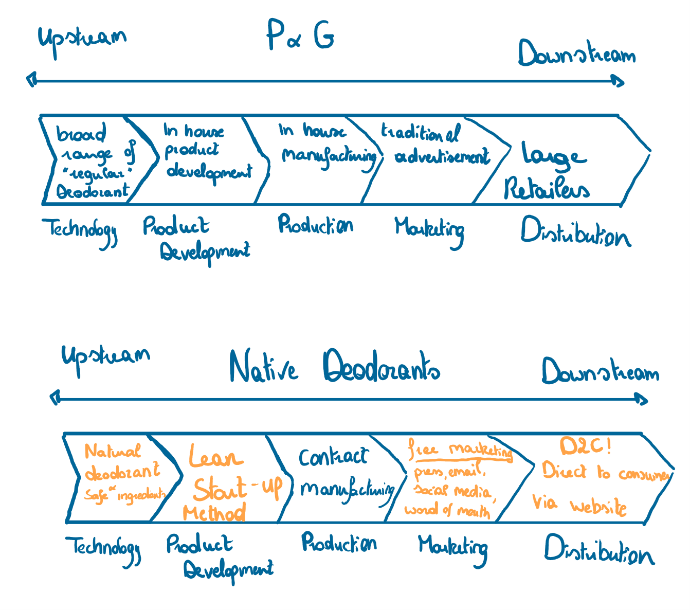
What is another minor area of disruption that Native Deodorants introduced apart from the active feedback loop and the D2C model?
Marketing!
Native relied on free marketing through word-of-mouth, social media, and press coverage, building authentic connections with customers while keeping acquisition costs low.
Whereas P&G depends on costly traditional advertising.
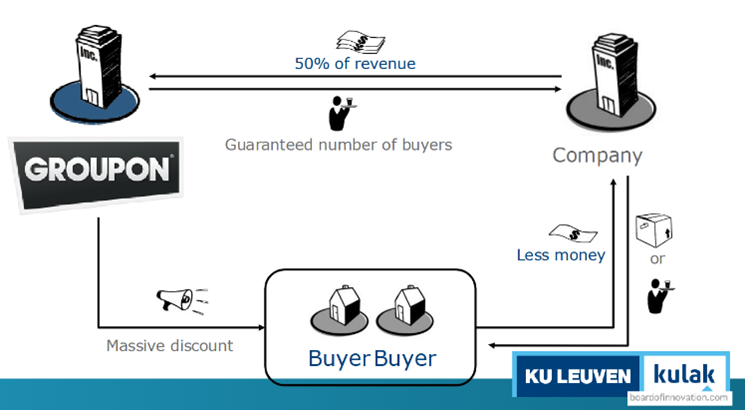
What does a value network represent?
A graphical representation of the value created and exchanged in a non-linear manner among various players. It visualizes the interactions between the company, its partners, and its clients.

How does the flow of value move in a value network?
The flows of value moves in two directions:
From the company to the client (e.g., products, services, experiences or reputation).
From the client to the company (e.g., money, attention, or exposure).
What is groupon
Groupon serves as the intermediary platform connecting businesses (partners) with buyers (clients).
In Groupon's value network, who are the main players involved?
The company (Groupon), partners (businesses offering discounts), and clients (buyers purchasing deals).
What is the flow of value from the company to the client in Groupon's value network?
Groupon provides massive discounts on products and services, incentivizing buyers to make purchases.
(It also guarantees a specific number of buyers for its partners.)
What is the flow of value from the client to the company in Groupon's value network?
Clients provide money to Groupon by purchasing deals.
They also contribute exposure to Groupon’s platform by sharing deals or encouraging word-of-mouth referrals, further growing Groupon’s user base.
How are platforms reshaping traditional business models?
By shifting focus from linear, supply-driven operations to dynamic, demand-driven ecosystems.
What is the difference between the pipeline model and the platform model in the mobile phone market?
The pipeline model focuses on controlling resources and linear sales, while the platform model facilitates interactions between producers and consumers.
For example, Apple does not create apps but connects developers to users, enabling the flow of resources.
How did pipeline models (traditional mobile businesses) relied on sales
By producing and selling more phones.
Their focus was on supply-side economics, controlling resources (manufacturing capabilities) and optimizing internally.
How did Apple disrupted the pipeline model of traditional mobile businesses
By introducing the App Store.
How does Apple’s App Store illustrate the platform model?
Apple created a demand-driven ecosystem where third-party developers create apps, and users access them.
The more developers joined to create apps, the more users were attracted to the platform, creating a network effect.
What is network value in the context of platform businesses?
Value created from interactions within a network where each additional participant adds value.
How do traditional businesses and platforms differ in their focus regarding operations?
Traditional businesses optimize internal operations, such as supply chains, whereas platforms focus on maximizing external interaction between users and app developers.
For example: Apple provides developers with tools (like the iOS SDK) to make app creation easier and incentivizes users with seamless app access through the App Store.
What is the difference in value creation between pipelines and platforms?
Pipelines aim to create better products for customers, while platforms prioritize creating a thriving ecosystem where each additional participant, whether a developer or a user, adds value.
Why does Airbnb pose a significant threat to incumbent companies like Accor?
Airbnb poses a significant competitive threat due to its scalability, lower costs, and ability to attract diverse travelers seeking unique experiences.
Its platform appeals to both budget-conscious customers and high-end travelers, overlapping with Accor's target markets.
How does Airbnb's business model differ from Accor's traditional business model?
Airbnb operates as a hospitality platform that connects homeowners with travelers, avoiding the need for capital-intensive investments in physical infrastructure.
In contrast, Accor relies on owning or managing hotels, requiring heavy investments to grow.
What are the network effects in the context of Airbnb?
Once Airbnb's platform is built, its initial investment is done, allowing for growth through network effects as it can rapidly add more hosts (supply) and travelers (demand) without significant additional costs.
What is the significance of Accor's traditional business model in the context of competing with Airbnb?
Accor's traditional business model requires significant investments to grow, either through boosting occupancy rates or building more hotels, which is capital- and time-intensive, making it slower to adapt compared to Airbnb's platform.
What strategic actions has Accor taken to respond to the threat of Airbnb?
Acquisition of niche platform players like One Fine Stay.
Leveraging existing hotel infrastructure for shared office spaces to attract new customers like remote workers, thus diversifying its revenue streams.